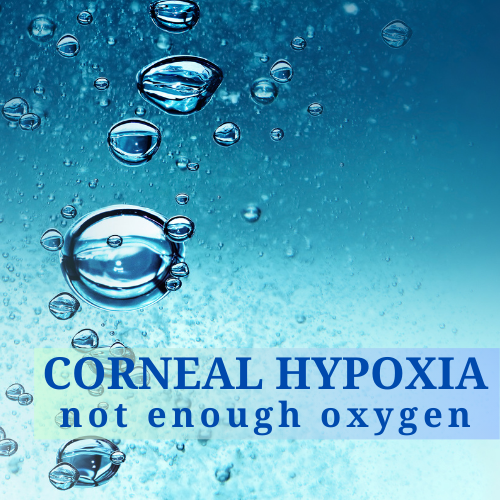Corneal Hypoxia


Corneal hypoxia means there is lack of oxygen.
Corneal hypoxia is when the cornea, the clear front surface of the eye, does not receive an adequate supply of oxygen. The cornea does not have blood vessels and relies on alternative mechanisms to receive oxygen.
The cornea normally obtains oxygen from the surrounding air and the tear film covering its surface. Oxygen dissolves in the tear film and diffuses through the cornea to reach its inner layers, where it is needed for metabolic processes and maintaining transparency.
When the cornea does not receive sufficient oxygen, several effects can occur:
Corneal Swelling: Insufficient oxygen supply can lead to corneal edema or swelling. The cornea relies on oxygen for its normal cellular function, including maintaining fluid balance. Without enough oxygen, the cornea may retain excess fluid, resulting in swelling and compromised clarity.
Reduced Corneal Transparency: The cornea requires oxygen for the optimal functioning of its transparent cells. Inadequate oxygen levels can disrupt the metabolic processes within these cells, leading to reduced transparency. This can cause the cornea to become hazy or cloudy, impacting vision.
Neovascularization: In response to low oxygen levels, new blood vessels may grow into the cornea from the conjunctiva, a condition called corneal neovascularization. These blood vessels are not naturally present in the cornea and can compromise its clarity and normal function.
Causes of corneal hypoxia
Corneal hypoxia can occur due to various factors, including long-term contact lens wear, especially with lenses that do not allow sufficient oxygen permeability. When contact lenses hinder the oxygen flow to the cornea, it can result in decreased oxygen levels and potential corneal hypoxia.
Proper contact lens care, adherence to recommended wearing schedules, and using contact lenses with high oxygen permeability (such as silicone hydrogel lenses) can help minimize the risk of corneal hypoxia.
Other factors or conditions can also lead to reduced oxygen supply to the cornea. Here are a few examples:
Eye Conditions: Certain eye conditions, such as keratoconus (a progressive thinning and distortion of the cornea) or corneal scarring, can affect the cornea’s ability to receive adequate oxygen.
Eye Surgeries: Some eye surgeries, including LASIK or PRK, may temporarily disrupt the cornea’s oxygen supply during the healing process.
Eye Inflammation or Infection: Inflammatory or infectious conditions affecting the cornea, such as keratitis or uveitis, can impair oxygen delivery to the cornea and potentially lead to corneal hypoxia.
Eyelid Disorders: Conditions like ectropion (outward turning of the eyelid) or entropion (inward turning of the eyelid) can affect the normal functioning of the eyelids and tear film, potentially compromising oxygen supply to the cornea.
Chronic Dry Eye: Insufficient tear production or poor tear quality associated with chronic dry eye can impact the stability and distribution of the tear film, potentially affecting oxygen delivery to the cornea.
Symptoms of corneal hypoxia
There are a number of signs of oxygen deprivation affecting the eyes. These include, but aren’t limited to:
- Blurred vision
- Burning pain in the eyes
- Red eyes
- Scratchiness or general irritation of the eyes
- Excessive tearing
- Visible swelling in the epithelial (outer) layer of the cornea
If you notice any of these symptoms, particularly if you are a contact lens wearer, you should schedule an eye exam.
Gregory Scimeca, M.D.
Ophthalmologist and Medical Director
The Eye Professionals
Our Locations
